|
CHAPTER IX
SYMBOLS,
VIGNETTES, TABLEAUX AND DIAGRAMS
The Cosmogonic Diagram of the land of Mu was the first book written
by man. I have traced this diagram back to more than 35,000 years
ago. Just how long it had been in use before that, no one can say or
even estimate.
All the ancient nations copied the Motherland's diagram,
Only one retained its simple character with its original meanings:
the Yucatan Mayas.
The rest, except the Pueblos, added figures and
introduced dogmas. They gave some of the original figures different
meanings, so that the simple and beautiful symbol of the Motherland
became sadly distorted.
This was brought about by the unscrupulous
Egyptian priesthood. They first invented the devil, then they had to
find an abode for him, so they invented hell. Five thousand years
ago the devil and hell were unknown. The priesthood of India, seeing
the effect on the people of these inventions, were quick to follow
Set with Siva.
In Mu the novice was taught to learn this book thoroughly and to
repeat it as his belief in God and the hereafter, just as children
are taught their Bibles today.
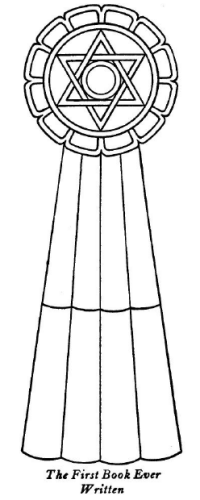
The Cosmogonic Diagram of the Land of Mu.
Over 35,000 years old.
In deciphering this cosmic diagram it will be seen that there is a
central circle enclosed within two interlaced equilateral triangles.
They form one single figure, having but one meaning. These two
triangles are enclosed within an outer circle, which leaves twelve
divisions between the two circles. Again, this outer circle is
enclosed within twelve scallops. Falling from the main figure and
downward is a ribbon that has eight divisions.
The central circle is a picture of the sun, Ra, who is the
collective symbol of the Deity, and as the Deity is in Heaven, the
Deity and Heaven being symbolized by this circle.
The twelve divisions formed by the two interlaced triangles, between
the two circles, symbolize the twelve gates to Heaven. Each gate
symbolizes a virtue, so that the soul must possess the twelve
virtues in order to enter the gates of Heaven.
The outer circle symbolizes the intermediate world, the world
beyond, the Amenti of the Egyptians.
The twelve scallops surrounding the intermediate world symbolize
twelve temptations. The soul must prove that it has overcome the
twelve earthly temptations before it can enter the twelve gates of
the world beyond.
The ribbon falling downward symbolizes that the soul must ascend in
order to reach Heaven. The ancient meaning of the word "ascend" as
used here did not signify rising to an altitude. It meant to rise to
a higher level towards perfection. The ribbon has eight divisions.
These signify the eight roads that man must traverse before his soul
may enter the world beyond.
I have given a description of what the eight roads to Heaven are in
the previous chapter.
What the twelve temptations and the twelve virtues were I have never
been able to discover collectively.
This ancient religious belief of the people of Mu, freely given in
modern language, would read:
"I believe there are eight roads which I must travel in order to
reach Heaven. After having traveled the eight roads (mentioning
them), I arrive at the twelve gates leading to the world beyond.
Here I must prove that I have overcome the twelve earthly
temptations (mentioning them).
I shall then pass through into the
world beyond and reach the gates of Heaven. There I must show that I
learned and practiced the twelve virtues on earth (mentioning them).
Then I am taken through the gates of Heaven to the throne of glory,
where sits the Heavenly King."
Have we today among all our sects and religions any that is purer
and more simple than this of the lost people of the Motherland of
Man?
Figures with Many Arms
During the years that followed the
translation of the tablets, we found the solution of many characters
which we could not read in the tablets themselves.
When deciphering
old symbolical figures, which writers and archaeologists call
"grotesque gods" and "grotesque goddesses," also bas-reliefs, we
found the undeciphered symbols mixed in such a way in these carvings
that their meanings became perfectly apparent.
Chandler and others
have written:
"Some grotesque Hindu goddess."
The following is a
specimen of these "grotesque gods" with the decipherings and
translations of it, by which it will be seen that the figure is a
tableau, depicting the advent of man in the land of Mu.
In India, especially, one is constantly finding carvings and
paintings of the figure of a man having more than one pair of arms.
These figures are found on temple walls, in illustrations in old
Hindu manuscripts, and are extensively used at the present time in
Hindu native jewelry.
These figures are not idols. They are sacred symbols of the Great
Creator and Creation. They are of a very intricate design and
character, the sort that one meets with occasionally when studying
the first writings of man. They symbolize the Infinite, the Creator
as having seven great or principal forces, attributes, powers,
desires, commands or intellects.
I have found each of these words
used in various ancient writings, such as:
"The Serpent with seven
heads, which are intellects or powers."
"The Serpent covered with
feathers, whose seven commands brought the world into existence and
created man to govern it."
The many-armed figures to which I refer undoubtedly originated in
the Motherland, although I first found them among the ancient
Brahmins.
It is a well-known fact in India that the Brahmins
obtained their cosmogony, science and arts of civilization from the Nagas. The Mayas in India, first called Nagas and afterwards Danavas,
came to India from the Motherland many thousands of years before the
Aryans became known in India. The Brahmins and the Nagas also used
the Seven-headed Serpent to symbolize the Creator.
The figure of a
man instead of the figure of the serpent appears to have been used,
especially for depicting special creations.
I have selected a carving of one of these figures which appears in
the Temple caves of Ajanta near Bombay, to decipher and translate.
It is especially interesting that it symbolizes the raising of the
Motherland above the waters, making it fruitful and productive, with
man about to appear upon it. The central figure is in the form of a
man, having seven points, the numeral of creation.
In this instance
a higher type of symbol is used - man, instead of the serpent. It is
repeatedly said that man was a special creation and endowed with
powers to govern the earth.
This tallies in many respects with the
tableau I am about to decipher.
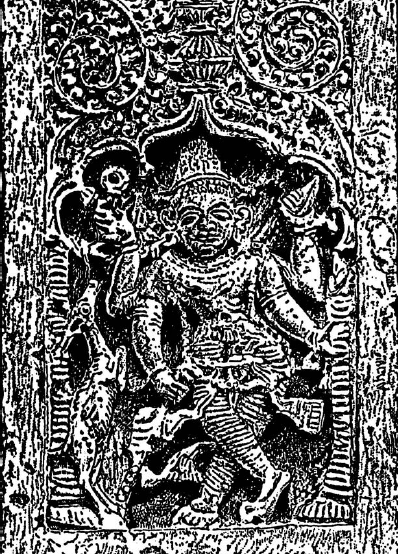
Symbolical Carving
The central figure wears the ancient sacred crown, a crown of
pearls, which was assigned to the Deity, showing him to be a king.
He is placed in the midst of creation, therefore he is the king of
creation. In the upper left hand he carries a fruit and in the right
hand the royal lotus, the symbolic flower of the Motherland, thus
denoting that the Motherland is habitable.
The figure is shown standing in water. Two distinct symbols tells us
this. First, the horizontal, irregular lines across his legs and the
lower part of his body. Second, the single-headed serpent held in
the lower right hand. Below the hand holding the serpent's head the
body of the serpent becomes a pod from which seeds are seen rolling
down.
These symbolize nature's germs or the cosmic eggs of the
ancients. These seeds or eggs have yet to break into life. Life
still lies dormant in them. In time the Vital Force brings these
seeds into life. The first of nature's life is thus depicted as
coming forth in the waters. That is why the ancients call the sea
"the Mother of Life," and this ancient conception has been proved to
be correct by the tales of the early Paleozoic rocks.
Thus far it has been shown how nature's life appears and is created;
it also shows that a habitable land exists above the waters. What is
this land? At the lower left-hand corner is seen a deer in the act
of leaping to the land. The deer, as we have shown, was the ancient
symbol for first man. Therefore, this tableau is describing the
Motherland, with man about to appear upon it.
The tableau is careful in differentiating between nature's creations
and the special creation of man, for nature's creations are shown as
seeds to be developed and brought into life, while man is shown as
appearing fully developed without having to go through any
evolutionary changes. It shows that man was not considered to be of
nature's making.
This beautiful symbol does not look much like an idol when one
understands it. It is a symbol confirming our Biblical teachings,
only this symbol originated tens of thousands of years before Egypt
was peopled.
This deciphering, by the way, is not complete, on account of the
mutilated condition of the lower left hand. The mutilation makes it
impossible to tell what it was supposed to depict.
The Seven-headed Serpent
This is one of the most interesting of
all the ancient symbols. Its origin was in the Motherland and it
symbolizes the Creator and Creation and is far-reaching in its
esoteric meanings.
In various writings it will be found under different names, but in
each instance the seven heads are referred to. I have been unable to
discover its original name in the Motherland, but in Hindu works I
find it called both Caisha and Narayana. In the Yucatan Maya it is
called Ah-ac-chapat, and today in Cambodia the name for it is
Naga.
This last appellation, however, is a modern christening, for it
gives to the serpent the name of the people. The Seven-headed
Serpent permeates all ancient writings because it symbolizes the
Creator and Creation.
Whenever and wherever we see it, we know it
says:
"I am the symbol of the Deity, the Creator. Looking at me
compels you to think of Him, I am the vehicle which carries your
thoughts to God."
At Angkor Thorn in Cambodia, which is a part of ancient Burma, there
are the remains of a magnificent temple that may be classed among
the architectural wonders of the world.
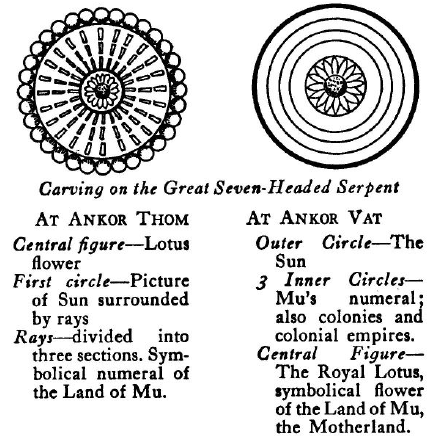
The Seven-headed Serpent
appears in many places among these ruins, but the principal one is
the approach to the temple. On either side of this approach are
carved Seven-headed Serpents, their heads upraised from eight to ten
feet. Their tails end at the temple walls.
These two Seven-headed Serpents have been an enigma to the many
archaeologists who have examined them, and all have placed
themselves on record as saying that the builders of this temple were
serpent-worshipers - all except one.
A lady who does not claim to be
an archaeologist, Helen Churchill Candee, in her fascinating book of
travel, Angkor the Magnificent, felt the heart-beat of truth about
these magnificent conceptions.
She writes:
"It is Naga. It is like
nothing else. The form is the result of centuries of legend and
belief, the tangible evidence of past religion and story. It is not
the fantastic creation of artist or architect, but the symbol of a
demigod. His attributes, his history, are matters to dig out of
inscriptions."
Madam Candee is absolutely right and all the others are wrong. These
serpents are symbols, but she did not carry her symbol high enough.
Instead of symbolizing a demigod, they are symbols of the Great
Creator of all worlds.
In front of their necks, and also at the back, are delicately carved
symbols of the Motherland, which are indistinctly shown in the
picture kindly supplied me by the American Weekly. I have, however,
separate sketches of these symbols which I made many years ago
before the French got possession of Angkor. Then it was a hard,
dangerous journey to reach Angkor from the coast, and I had some
quite thrilling experiences; but that is the usual thing with all
explorers - it is what is bound to happen.
Besides the American Weekly's picture I am giving cuts of two of
these carvings, with the deciphering and translations.
How did the Seven-headed Serpent get the name of Naga in Cambodia? I
can see only one possible way - the design came to Burma from the
Motherland tens of thousands of years ago, brought there by the
Nagas. The Nagas were wiped out by a cataclysm, a new people
occupied their land when it became habitable again.
They gave the
name to the serpent, calling it after the people who first brought it.
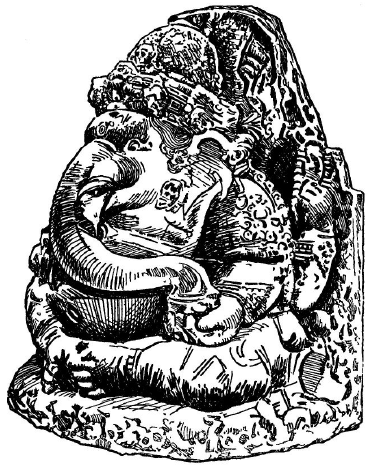
Ganesha, The Lord of the Fields and Crops. Ganesha, the elephant.
The symbol of that attribute of the Deity which cares for the
fields, gardens and crops.
And while we are at Angkor, let us consider another carving.
There
are conventional beasts there called by archaeologists "lions." That
they are symbolical is shown by the shape of their mouths, an
elongated square - one of the symbols given to Mu. These beasts are
carved in a rising position, with their faces looking towards the
east, the direction of the burial ground of Mu.
From end to end in
Angkor one meets the constant cry from the stones,
"Mu, Mu, the
Motherland!"
The illustration shows Ganesha.
He has been called a lot of bad
names by those who did not know who he was. The Hindus, however,
knew who this god was and adorned his likeness with flowers, for Ganesha was the symbol of the god who cared for the fields and crops
and whose ancient name was "Lord of the Lands and Crops."
This symbol came from the land of Mu. I do not know what his name
was there, but should judge it was either Ra Ma (God of the Lands)
or Ra Mana (Lord of the Field and Crops). The Yucatan PPeu dynasty
of kings adopted him as their symbol, claiming they were the lords
and owners of the land.
In Yucatan, on the buildings erected during the PPeu dynasty,
elephants' heads are found carved in prominent parts of the
structures. In ancient times it was always usual to carve the symbol
of the reigning kings on all palaces and governmental buildings.
A Naga-Hindu Knife
I have in my possession a knife which I
believe to be the oldest knife in the world and which is said to
have been worn at one time by an ancient Naga king.
As elsewhere
stated, the Nagas were Mayas, who came to India from the Motherland
by way of Burma. They settled in the Deccan and eventually turned
this settlement into a colonial empire known as the Naga Empire.
Their capital city was on the spot where the city of Nagpur now
stands.
It is not known when the Naga Empire ended. Legends point to about
5000 years ago. There are innumerable Hindu records, legends and
traditions. Valmiki does say, however, that it was the First Hindu
Colonial Empire of the Motherland.
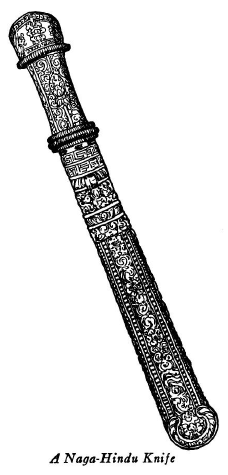
A careful examination shows that the present blade of this knife is
not the blade originally fitted to the handle.
The blade now
attached is not of steel at all, but of hard iron. It is riveted to
the handle by a hardened copper rivet. To make the blade fit the
sheath, an overlying ring is put on the blade, close to the handle.
Everything points to the probability that the original blade was
either bronze or tempered copper and that it was thick enough at the
handle to fit the sheath without the ring. The handle of the knife
and the scabbard are of silver, richly carved with symbols,
hieroglyphics and Maya tracings.
Apart from the interest that may be taken in the age of the knife,
there remains a greater interest in the hieroglyphics and symbols
which are carved upon the handle and scabbard. One symbol opens up
an immense field for research work.
The symbols which appear on the handle of the blade, front and back,
are conventional tableaux, telling us who the people were that made
this knife and whence they came.
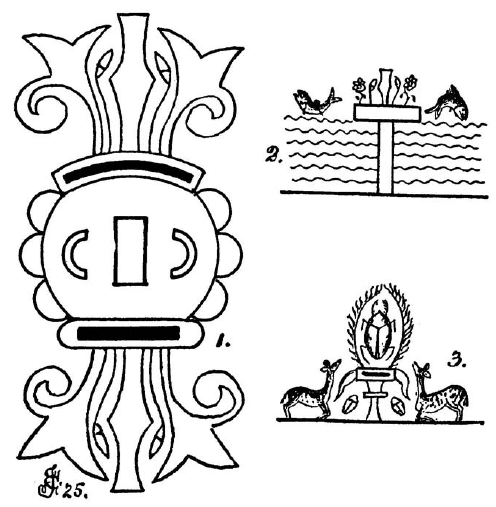
Symbols on the Handle and Sheath of the Knife
Fig. 1 - I will first take the symbol on the front of the handle.
This is a tableau both symbolical and conventional. That it refers
to the Motherland is plainly told by the many times the number three
is repeated - three being the symbolic number of the Motherland.
The face depicted is a conventional face, in which two elongated
squares form the mouth and the nose. This symbol reads "Mu, the
Motherland." I can prove this statement because it is substantiated
in the tableau.
First, in the crown and plumes which adorn the head.
The headdress is composed of three - three times repeated. Second,
with an ancient water jar with a bud of the royal lotus on either
side, thus denoting that the land stood in the midst of water and
that it was Mu, the land of the royal lotus.
On each side of this
triple figure is a conventional plume which makes the main three. Each of these plumes is trifurcated so as to produce three points.
The hieratic letter "k" is on each side of the conventional nose and
is used to denote the four cardinal points: North, South, East and
West. These are conventional eyes looking east and west in the
direction of the two main lines of colonization, as is shown in the
next tableau.
The cheeks are arched to symbolize the horizon. On both horizons are
three suns appearing as semispheres without rays. The sun appearing
on the horizon without rays symbolized a colony, with rays, a
colonial empire.
The lower part of the figure is put there to balance the whole and
give an artistic effect. At each side of the tableau is engraved a
fully open royal lotus, thus emphasizing the fact that Mu, the
Motherland, is indicated.
From the foregoing it seems evident that the knife was of the date
of the Naga colonial days.
Fig. 2 - On the back of the handle is a tableau showing Mu standing
in water, with two fish jumping along on top of the water, one
traveling east, the other west. This symbol shows that India was
separated from the Motherland by water and that the Nagas crossed
the ocean to get to India. Their mode of travel is amusingly and
very effectively told by the fish being out of water and neither
flying nor swimming but hopping along the surface. Berosus, the
ancient Chaldean priest and historian, spoke of the Akkad-Mayas as
being half fish and half man.
The rest of the handle is carved in artistic Maya patterns.
Fig. 3 - The scabbard commences with five bands of pronounced Maya
traceries. Below these bands is a tableau, a compound hieroglyphic
which no doubt will be astounding to all students of archaeology. It
is most amazing to me to find it in India. The central figure in
this tableau is a scarab rising through rays of glory.
Beneath is
the symbol of earth, or mother earth - the hieratic letter M -
which is shown to be productive by the conventional leaves drooping
from each end of the symbol. Beneath the surface of the earth are
two young scarabs still unborn to light. On each side of the risen
scarab is the symbol of the first man, Keh, the deer, both in the
act of adoration. This shows first man in adoration of the scarab
beetle.
What does a scarab beetle symbolize?
This is the first time I have come across the scarab in India, in
either writings or carvings. The scarab has hitherto been looked
upon as being a purely Egyptian symbol. It was selected by the
Egyptians as the symbol of the Creator, who was called Kephera. On
the headdress of Kephera, the scarab always surmounts it.
Anana, the king's scribe and companion of Seti II, in one of his
beautifully illustrated papyri, gives the following reason why the
Egyptians selected the scarab to symbolize the Creative God:
"The scarab rolls up little balls of mud with its feet and in these
balls deposits its eggs, there to hatch out. The Egyptians think
this a perfect example of the Creator rolling the world around and
causing it to produce life."
This italicized sentence would be startling to the modern scientist
if he understood about the origin and workings of the Forces,
because here it is shown that the Egyptians, 3000 or 3500 years ago
understood the origin and workings of the Great Forces, which I
shall hereafter explain from the Hindu translations. Anana carries
us back 3500 years only, but the carvings on this knife's scabbard
will carry us back to a time before the Egyptians came to Egypt.
The symbol on the front of the handle tells us that this handle and
scabbard were made when the Nagas were only a colony in India.
Now I shall try to fix an approximate date of the Naga colony in
India before it became a colonial empire.
One prominent figure in the Naga or Maya Empire in India was Prince
Maya. The time of Prince Maya is doubtful. Although I have come
across many records about him, not a single one even estimates the
date when he lived; but according to traditions, and these
traditions are as plentiful as leaves on a tree, Prince Maya lived
15,000 to 20,000 years ago.
In Ramayana, we find this reference to him:
"In olden times there
was a prince of the Nagas whose name was Maya."
Prince Maya was the author of the Sourya Siddhanta, the hoariest
treatise on astronomy in India. Its age has been variously estimated
at from 10,000 to 22,000 years.
At the time of Prince Maya, the Nagas were an empire. When the
handle and sheath of this knife were made, the Nagas were a colony
antedating the Empire. That they were only a colony is clearly shown
by the suns without rays on the horizon. This proves the extreme
antiquity of the handle and sheath.
ANCIENT MAYA TABLET
This tablet is of fine hard sandstone. It is
sculptured so as to raise the glyphs about 1/16 of an inch.
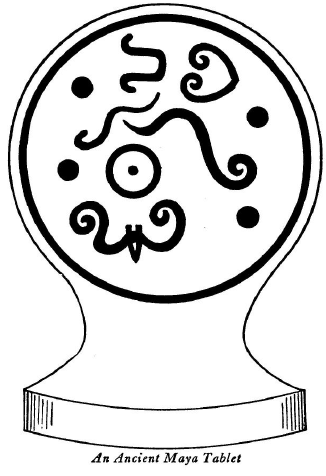
The
ground within the circle on which the glyphs are carved is colored a
light yellow, the balance of the stone is highly glazed in blue. The
glyphs are dark red and as highly glazed as glass. This combination
of colors is often found in old Maya relics.
The tablet stands about 4 inches in height. The bottom is flared so
as to make a standing base on it It was evidently an ornament to
stand in some conspicuous place in the house of its owner.
To me, there is a mystery connected with this tablet as it is
written not in the Maya hieratic, but in the temple writings of the
Motherland with the Naga pattern of glyphs. This particular form of
writing was known only to the high priesthood and a few other
prominent priests, so that the value of the tablet could only be
appreciated by this caste, or by the heir apparent to the throne who
was initiated into the sacred mysteries.
I shall now dissect and decipher it, and see what historical tale it
has to tell.

1. The symbol of the Creator - the Great Ruler - the King of Kings -
and was applied to Mu as the Suzerain of the whole world. The Codex
Cortesianus uses this application by calling Mu the Great Ruler.
2. This is the hieratic letter U in the Motherland's alphabet, and
the symbol of an abyss, a hole, a great depth.
3. This is a compound symbol being composed of the letter U with the
symbol of rolling over or in over. Used where the submergence of
land is shown.
4. This is the symbol for a rolling movement like the swell of the
ocean. It is the ancient symbol for water.
5. This is a compound symbol composed of the ancient symbol for the
fires of the underneath and the symbol of a road beneath the ground.
6. This is a word: Kuiland.
7. This glyph consists of two words: Kuiland dead.
8. This glyph consists of a sentence: Kuiland dead and submerged.
9. This glyph is the symbol of a pillar and an earthquake.
10. The Great Ruler is falling into an abyss of fire. I shall now
connect up these sentences in the form of a legend.
The Legend
Kuiland, the Great Ruler of the earth, exists no longer.
She was shaken up and down by earthquakes in various places, and the
land rolled like ocean waves.
Finally the pillars which were
supporting her gave way and she sank into a fiery abyss. As the
Great Ruler went down the flames of the underneath rose and
enveloped her. Then the waters rolled in over her and submerged was Kuiland, the Great Ruler.
In writing the legend I have followed strictly the writings on the
tablet and am simply putting ancient language into modern, so that
the layman can as thoroughly understand it as the scientist.
A Bronze Statuette of Mu as the land where Man is receiving his Soul
from The Creator. Thus making him the Special Creation (please see
halftones). The figure is Mu, Ma or Mother and is shown as a woman
in sleep. Her eyes being closed she has not yet received - life. The
Soul is depicted as a man-headed bird resting on her left shoulder,
and about to enter the body.
This symbolization is very interesting,
as we find in the Egyptian Book of the Dead, Chapters 17, 29, 85,
91, etc., the soul of man shown as a man-headed hawk. The Egyptian
is from two to five thousand years later date.
The age of this bronze would somewhat depend on where it was made.
It was either in the Motherland itself or in the Uighur Colonial
Empire.
As an object of art - in its beauty and perfection of workmanship -
it compares favorably with the finest and most delicate compositions
of today.
I know its history perfectly, but do not feel warranted in stating
more about it than to say where it came from and how it reached
America. After lying many years, dust covered, in a garret, it now
reposes in a safe deposit vault.
During a period of the last century there was considerable
disturbance in China, with much looting of palaces and temples. The
reader can imagine where the bronze came from. With other antiques
of great value, it was brought on board an American warship lying in
the harbor and sold to an officer of that ship.
The antiques are in
the families of his descendants, who only recently became aware of
their extreme value.
The Great Monolith at Tiahuanaco, Peru
This immense stone has been
one of the great wonders and enigmas to all archaeologists who have
ever looked upon it or its picture.
To the archaeologist it is one
of the wonders of the world. Perched up on the shores of Lake
Titicaca, 13,500 feet above the level of the Pacific Ocean, it rests
as a part of a ruin of a temple.
Much has been written about this stone, and the consensus of opinion
among the various writers is:
"If it could only be deciphered and
read, what a wonderful tale it might possibly tell about the ancient
past I"
This stone does tell a wonderful tale, for it takes its
readers back 16,000 years, when Mu, the Motherland still held her
proud sway throughout the earth, before she sank into that fiery
abyss to be mourned by mankind for many thousands of years.
It tells
about the times when the first settlements were being made in Egypt
on the Nile Delta under Thoth - the dawn of Egyptian history.
At the time the temple was built with its magnificently carved
stones, the Andes Mountains did not exist; they had not yet been
thrown up through the plains of western South America.
It was the
raising of these mountains that destroyed the country, most of the
people and this temple, in doing which this great monolith was
fractured into two pieces.
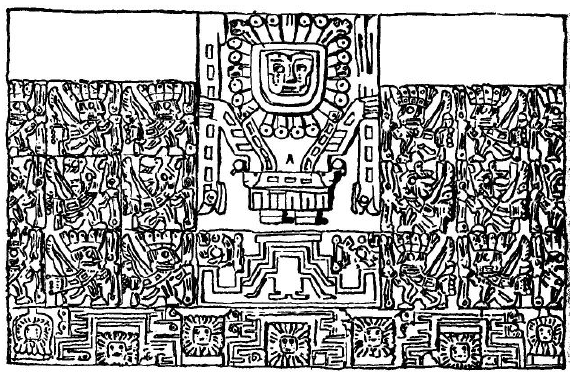
The Great Monolith at Tiahuanaco
Many writers, I find, assign this stone to the work of the Incas.
The Incas did not come to Peru for about 15,000 years after this
temple was built. When the Incas (Quiches) arrived in Peru, the
Andes Mountains had been in existence many thousands of years.
It is a wonderful old stone, for although a hieratic alphabet had
been used for a long time, not a letter appears on it. This carving
follows along the lines of the first forms of writings ever used - a
combination of symbols forming a picture, the picture forming a
writing. It is most unusual to find a carving of this date without
hieratic writings forming a part of it; yet, without these writings
the picture is as easy to read as a present-day printed book. All
that is needed is a knowledge of the meaning of symbols.
The excellence of this stone shows great mechanical skill and
artistry.
Now, with the aid of the symbols of the Motherland and those
specially used in her colonial empires I shall decipher it and read
it to you.
On looking at the picture of the carving the most prominent object
which strikes the eye is a conventional head of a human being; and
the most striking point of this head is the number of times the
numeral three is woven into it. Three, as previously stated, was the
numeral assigned to Mu. I shall now dissect the head.
It consists of three superimposed layers forming an escutcheon, the
uppermost of which is sculptured so as to represent the human face.
Above are three feathers forming a plume, and beneath a triple
throne, which the figure surmounts. On each cheek there are three
dots. The breastplate, if it can be so called, contains three oblong
squares, which is one of the symbols for Mu (the geometrical and
alphabetical symbol).
The scepter at its end is adorned with three macaws heads. The shape
of the mouth is also conventional, an oblong square. Here nine times
it says Mu. The head is surrounded by rays divided into groups of
four.
This makes a complete circle of rays, and is a part of the
symbol reading,
"Mu, the Empire of the Sun."
The termination of each
ray is (Circle with dot in centre), Ahau - King of Kings; thus
saying:
"The Emperor of the Empire of the Sun was the king over all
of the earthly kings."
The macaws' heads at the end of the scepter are a colonial symbol,
the totem of Queen Moo of Mayax, and, being attached to the scepter,
designate that Mayax was a vassal state or colonial empire.
On the
rays of the upper angles are leopards' heads, also appearing on each
side of the escutcheon. The leopard was the totem of Prince Coh, the
brother husband of Queen Moo. At the lower angles are serpents'
heads, the symbol of the Can dynasty. Thus the central figure tells
us that Queen Moo with her husband Coh of the Can family are
reigning in Mayax, and that Mayax was one of Mu's colonial empires.
On the lower band are sculptured seventeen small heads, over each
head and on either side are the symbols for land. The definite
meaning of this I cannot state. It may mean that Mu has seventeen
colonies; again this may not be the actual meaning.
Above this band are three bands of winged figures. Those in the
middle row have macaw heads, indicating their allegiance to Queen
Moo. The figures in the other two rows have human heads, but wear on
their crowns Queen Moo's totem, showing that they recognize her as
their sovereign.
All these figures are ornamented with twelve serpents, symbolizing
the twelve Maya dynasties who ruled over Mayax.
The whole picture combined shows that the inhabitants of this land,
where this temple was built, were vassals to or a sub-colony of
Mayax at the time Queen Moo and her husband Coh were reigning in
Mayax.
Queen Moo visited the Maya colony at Sals on the Nile Delta during
the first century of its existence and there met Thoth, its founder,
according to the Troano Manuscript. The Nile colony was started
16,000 years ago; therefore this great monolith of Tiahuanaco was
carved just 16,000 years ago.
Carved Stone at Anarajapura, Ceylon. On account of the shape of this
stone, which is a half sphere, it has been called by archaeologists
who have visited Anarajapura, "the Anarajapura Moon Stone."
There
are several of them and they are placed at the foot of the steps
leading into the temple.
That this is a symbolical stone, telling who the Cingalese were and
whence and how they came to Ceylon, has been overlooked by
archaeologists, yet the writings are quite plain and distinct.
The center of the stone is carved as a conventional but elaborate
lotus in full bloom. This, of course, is the symbol of the
Motherland, the land of Mu. It was adopted as such, so Oriental
traditions say, because it was the first flower to adorn the earth's
surface.
There is every reason for believing that these traditions
told the truth and that the lotus was the first flower to appear on
earth.
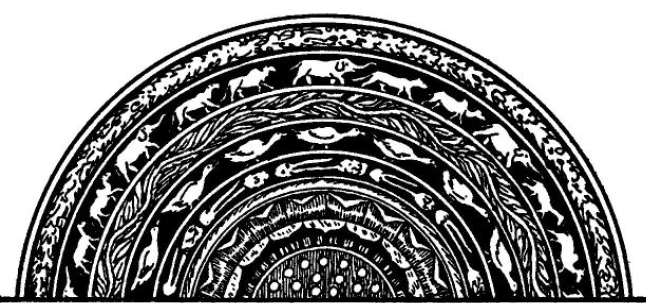
One of the Symbolic Stones, Anarajapura, Ceylon,
called by
Archaeologists 'Moonstones'
Carved on the stone is a series of half-circles, one of the symbols
of a colony of the Motherland. On account of the bad condition of
the outside band beyond the animals, I am unable to say whether it
was an ordinary colony or a colonial empire.
Beyond the lotus is an ornamental band. This has no symbolical
significance, unless it symbolizes water. It is also too indistinct
to warrant any definite conclusions.
The next band consists of a procession of ducks, indicating the
manner in which the colonists came to Ceylon. Like ducks they came
on the surface of the water; that is, they came in their boats.
Outside of the procession of ducks is a band which, without doubt,
is ornamental only, carved there as an artistic dividing line
between the procession of ducks and a procession of animals. This
procession of animals is divided into sets of three, the symbolic
numeral of the Motherland.
Freely read, the symbols on this stone say:
"These people who came to Ceylon came there from a colony of Mu, in
their boats, the road being across the ocean and their forefathers
came to that colony from the Motherland."
Anarajapura was not an old city, about 2200 years only, but before
it was built Ceylon had been occupied by a warlike race for at least
10,000 years, as recorded by Valmiki, the Hindu sage and historian.
Back to Contents
|









